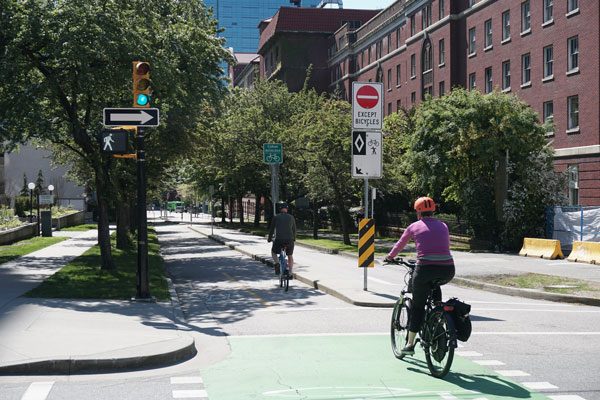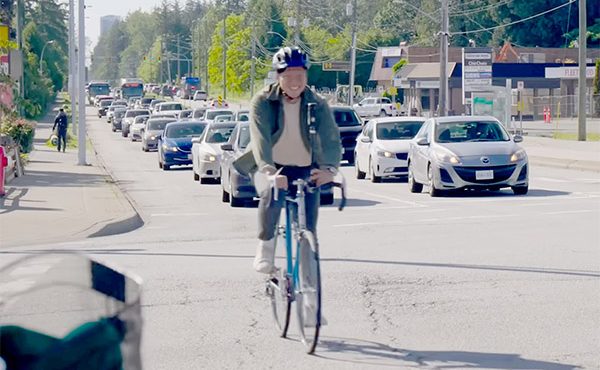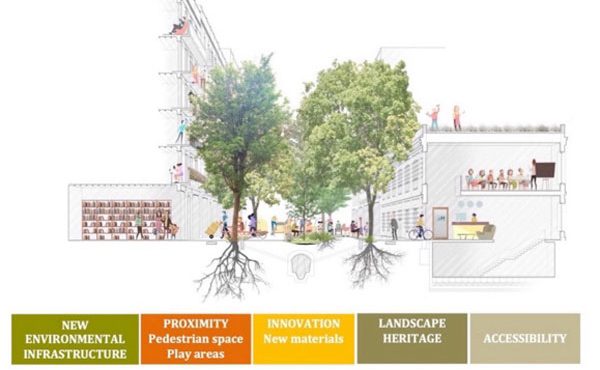
Cities working to prioritize active transportation with the aim of reducing neighbourhood carbon emissions now has some of the first scientific evidence. A new study from the University of British Columbia’s Health & Community Design Lab tracked a group of 524 residents living near Vancouver’s Comox-Helmcken Greenway for a period of three years—a year before and after its completion in 2013. About half of the 524 participants lived within 300 metres of the greenway, and the rest were within a 500-metre radius. Greenways are landscaped and traffic-calmed pathways with a mix of bicycle facilities and other streetscape improvements that link open spaces, parks, public facilities, and neighborhood centers, while supporting a variety of active travel uses, including walking, running, bicycling, and skating.
Results showed that the closer group (300 metres) reduced their daily car or bus travel distance by 18 per cent after the greenway was built. More specifically, “participants logged 2.8 kilometres of car or bus travel per day, compared to 3.4 kilometres the year before.” As a result, residents generated 21 per cent less travel-related emissions, producing an average of 520 grams of emissions a day, from 660 grams the previous year.
The group that lived more than 300 metres away did not show the same reductions in car or bus travel. Their motorized travel actually increased by 37 per cent to an average of 2.6 kilometres per day per person, from 1.9 kilometres previously. In addition, their average individual carbon emissions grew to 510 grams per day, from 330 grams previously. The study noted that these increases in the second group likely stem from the boom in car-sharing services like Car2Go in the West End during this period, which made driving easier for the already pedestrian-oriented population.
“Clasiq Car sharing was growing across the city, and people who lived farther from the greenway likely found it more convenient to car share compared to those who were closer to and more influenced by the greenway,” said the study’s senior author and principal investigator, Dr. Lawrence Frank. “Three hundred metres from a greenway would seem to be the optimal distance for maximum environmental benefits.”
The Comox-Helmcken Greenway spans two kilometres and features cycling paths, parklets and public seating. It runs west to east from Stanley Park to Hornby Street in downtown Vancouver. According to Lon LaClaire, director of transportation for the City of Vancouver:
A key part of our transportation work at the City is to make walking, cycling and public transit the preferred transportation options in order to reduce greenhouse gas emissions and reduce congestion. Part of achieving this has been to create reliable and comfortable bike routes that are usable by people of all ages and abilities, so that deciding to bike to work or for an errand is easy. We have seen tremendous growth in people choosing to cycle to get around, and we have reliably seen that creating new all ages and abilities facilities has drawn more people to travel by bicycle. This study confirms that the key objective of these projects is being achieved.
Ultimately, this research hopes to better guide decision-making for transportation investments towards climate change action. In Canada, passenger road transportation accounts for 19% of all GHG emissions, with a continuing trend of rising emissions from increasing total vehicle-kilometers travelled and the number of motor vehicles. As a result, major transportation decisions made at the local and regional levels will need to prioritize strategies that most effectively reduce GHG emissions. Investments in active transportation infrastructure are considered an important way to reduce motor vehicle use and emissions.
A major takeaway from this study is that emission reductions can still be made in high-density, compact neighborhoods with relatively low vehicle ownership, through modest investments in active transportation facilities.
The research was published in the July issue of Transportation Research Part D: Transport and Environment. https://www.sciencedirect.com/science/article/pii/S1361920917303565
***
Victor Ngo is a sustainable mobility expert and is currently a Transportation Planner at WATT Consulting Group and a Research Associate at the UBC Health & Community Design Lab. He holds a MA in Planning and a BA in Geography from the University of British Columbia.




